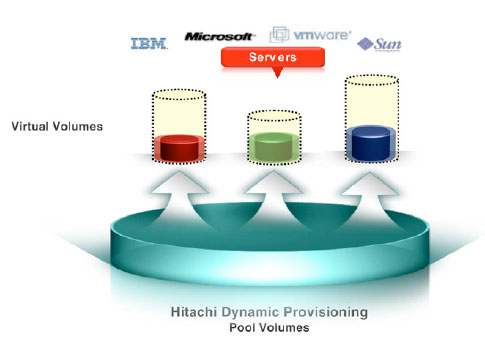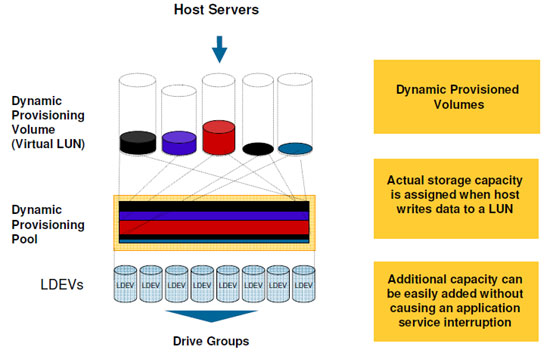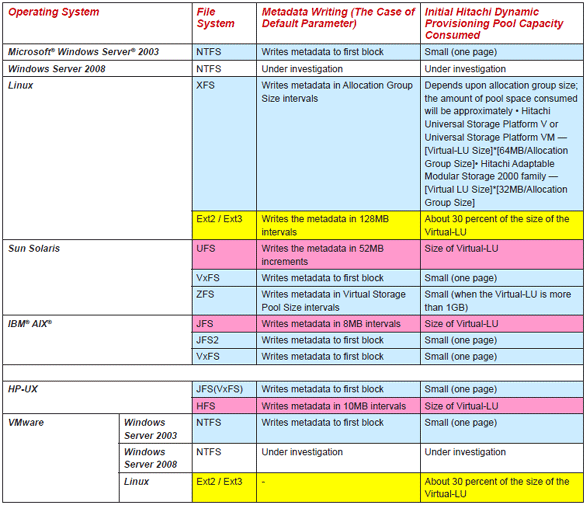Specialized Section
Dynamic Provisioning – No-limit Capacity
01.03.2012, 12:32
Disk array and centralization of company data into one reliable device is a very efficient way to economies and reliability. But it is only the first step and the practice shows that in spite of all advantages of disk array there may be a huge waste of capacity and investments, which had to be made in connection of disk array purchase. How this waste happens and what the solution is and what actually Dynamic Provisioning is – read the following.
Perhaps you have already heard this story:
- Database administrator needs 2GB LUNs for a database. He rather asks the storage administrator for 10GB just in case.
- Storage administrator thinks about the requirement and thinks to himself that when the database administrator runs out of space such as the last time, it will mean LUN expansion, file system migration... shortly a lot of work. So he gives him 50GB LUNs instead.
The result is that there is a waste of 48 GB of space on the expensive FC or SAS disks! Is there a solution? – It lies in a mechanism of separating the allocated capacity from the real physical capacity - or Dynamic provisioning.
Dynamic provisioning
Efficient assigning and disk capacity administration eases the life of administrators and saves the finances. This technology is Hitachi Dynamic Provisioning (HDP), which has been available for two years on Hitachi USP-V enterprise disk arrays and also on Hitachi AMS2000 modular arrays.
The standard approach to disk arrays lies in allocating the installed capacity towards servers. If the disk array has 1TB of capacity, I can allocate this capacity to the servers. This physical capacity is then occupied regardless of if the file systems of servers use it or if it is unused.
Provisioning enables to configure virtual capacity. So I can allocate capacity to servers all as I want – also the capacity, which is physically not on the disk array yet.

What is the principle for preserving the data consistency?
Of course it is necessary to install physical capacity on the disks while using the Dynamic Provisioning principle too. The difference lies in this – physical capacity doesn’t configure to LUNs, which are assigned to application servers, but configures to so-called HDP Pool. HDP Pool represents a supply of physical installed capacity (GB). Above this HDP Pool the huge capacity over-dimensioned virtual LUNs are defined (virtual capacity is unlimited and for free), which are mapped to application servers as usual.
Application servers can ‘see’ these virtual LUNs as common SCSI disks and work with them accordingly. HDP technology is completely transparent for application servers. In case of recording of data to virtual LUN the data are recorded to HDP Pool and virtual LUN contains only link where the data are stored. Thus only the real used capacity is spent from HDP Pool.

Hitachi Dynamic Provisioning Advantages
Essential advantages are:
- it significantly simplifies the storage administration
- it raises the performance towards servers
Thanks to that storage administrator does not have problems with RAID groups’ design, LUNs’ size and their subsequent enlarging in operating systems, which may be a problem in some OS and applications.
Thanks to provisioning the virtual capacity is assigned towards servers sufficiently in advance independently of physical capacity. When the servers are writing, the actual occupying of physical capacity blocks in storage pool is happening.
The job of administrator is to take care of HDP occupancy. If the filling of HDP Pool (of which the administrator is notified by adjustable trigger – percentage value) is approaching, the storage administrator enlarges HDP Pool by adding new disks into disk system. Once HDP Pool in enlarged, the process of optimization automatically starts up, which distributes the stored data uniformly so the maximum performance is achieved.
Another benefit of Dynamic Provisioning technology is boosting of performance in comparison to standard disk array.
Disk array controller, which is defined as Dynamic Provisioning pool, approaches to space as well as to strip through all available disks.
Performance is ensured by used type of disk and their number – the classic dividing of physical capacity of disk space to relatively small raid-sets, where the limiting factor is usually the number of disks of these small raid-sets in light of performance, does not take a place.
Benefits resulting from Dynamic Provisioning for various OS
It is good to consider what OS and what application should be used above the disk array in Dynamic Provisioning mode. Benefits of this technology are among others dependent on what file system is used and how this file system acts towards storage.
Disk array itself is transparent and allocates a physical capacity to every stored data block. But the disk array cannot ‘know’ how the file system allocates the physical capacity (or pre-allocates) and that is why the efficiency of this technology is different for different OS and file systems. See the table:
Key
- blue box: “Dynamic provisioning friendly” – Dynamic provisioning is highly efficient
- yellow box: Dynamic provisioning brings partial benefits
- pink box: Dynamic provisioning doesn’t take effect

